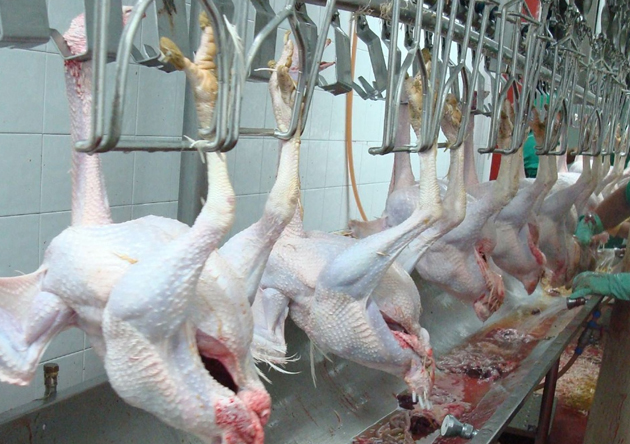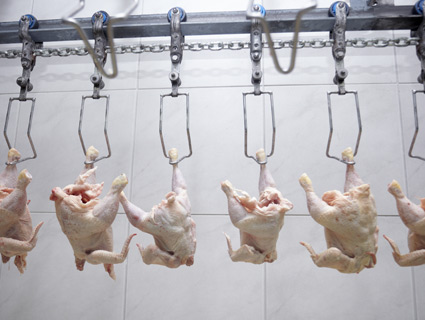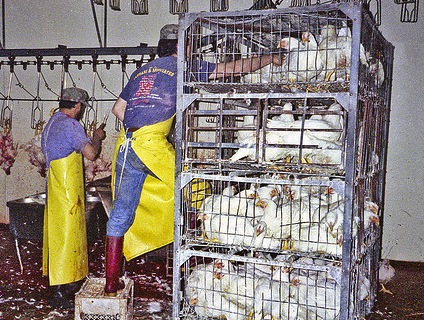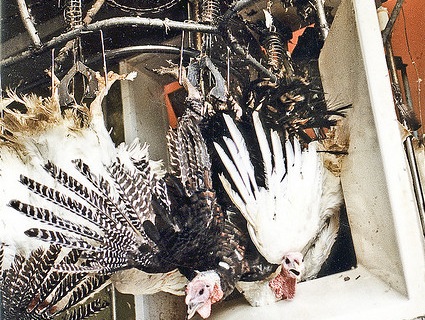Think you have it tough at work? Imagine taking a post at a factory-scale poultry slaughterhouse. Chicken carcasses whiz by at the rate of 140 per minute, requiring repetitive hand motions with sharp knives. Then there’s the caustic odor of chemical sprays and washes—practices the industry has resorted to in recent years as a way to control bacterial pathogens like salmonella.
The US Department of Agriculture, which inspects the kill line at these plants, has been brandishing a proposal since 2012 that would remove some inspectors from the kill line while allowing the industry to speed them up to a rate of 175 birds per minute—a 25 percent acceleration. The speedup would likely increase reliance on those antimicrobial sprays to manage pathogens: In the USDA’s proposal, “visibly contaminated poultry carcasses” would be allowed to remain on-line for treatment with germ-killing chemicals, instead of being taken offline for cleaning, as is the current practice. For companies that opt to keep their “visibly contaminated” birds on the kill line, “all carcasses” on the line would be doused with antimicrobial chemicals, the proposal states, “whether they are contaminated or not.”
The department has delayed finalizing the highly controversial new setup, but keeps stubbornly repeating its intention to do so, eventually. As recently as April 3, Brian Ronholm, acting under secretary for food safety, touted the plan before a House subcommittee.
Meanwhile, new information on the already-harsh conditions that prevail on the factory-slaughterhouse floor has emerged over the past month. On the chemical-spray front, the above video, from Atlanta’s WSB-TV News, shows that some USDA inspectors in the southeast are complaining publicly that the antimicrobial sprays are causing them, as well as line workers, serious respiratory troubles. The Atlanta report builds on an excellent 2013 story by the Washington Post’s Kimberly Kindy, who conducted interviews with more than two dozen USDA inspectors and poultry industry employees, and found a “range of ailments they attributed to chemical exposure, including asthma and other severe respiratory problems, burns, rashes, irritated eyes, and sinus ulcers and other sinus problems.”
Than there’s this March report by the National Institute for Occupational Safety and Health on a plant in South Carolina operating at the current maximum speed of 140 birds per minute, which found that 42 percent of the workers had carpal tunnel syndrome, an extremely painful condition brought on by repetitive motion.
Stunningly, the USDA trotted that report out in defense of its speedup plan. The report, requested by the USDA itself, did find that carpal tunnel rates at the South Carolina plant did not rise 10 months after its line speed increased from 140 birds per minute to 170 birds per minute. In a triumphant March 26 blog post, Al Almanza, administrator of the department’s USDA Food Safety and Inspection Service, hailed that result, declaring that NIOSH researchers had shown that “the increase in evisceration line speeds was not a significant factor in worker safety”—a statement he saw fit to underline for emphasis.
In a scathing April 7 retort, NIOSH director John Howard claimed that his agency’s report drew “no such conclusion.” He called the finding of carpal tunnel syndrome at a steady rate of 42 percent “alarming,” adding that the 10 months between the researchers’ two visits was “not sufficient to result in a change in health status.”
Moreover, the plant didn’t just speed up its line, it turns out. It combined two lines, each operating at 140 birds per minute, into a single one operating at 170 birds per minute—and kept all of the employees working on the combined line. That meant that “the number of chickens handled by most workers and the total production remained the same at the time of our follow-up visit,” the report clearly states. Howard noted that because of the unusual arrangement, “no conclusion can be drawn” from the report about “the effect of line speed changes on worker health.” This assessment was made clear in the report itself, which stated that “this plant may not be representative of all plants that may increase their evisceration line speed.”
Yet the USDA is sticking by its creative reading of the NIOSH report. In an email to me, a USDA Food Safety and Inspection Service public affairs specialist reiterated that “increased line speed at this plant did not result in an increase in injuries” at the plant. The specialist added that the report “illustrates that a plant can adjust its processing so that increased line speeds do not necessarily lead to more birds being processed per worker, a fact FSIS has continued to point out.” Fair enough. But FSIS has also repeatedly claimed that the sped-up system would benefit poultry processing companies to the tune of “at least” $256 million annually in reduced costs. It’s hard to imagine where that cool quarter-billion in annual savings would come from, if not from each worker processing more birds per minute.
At any rate, the report shows definitively that even the current maximum line speed is sufficient for generating “alarming” rates of carpal tunnel among workers.
Finally, things have gotten so dire on the poultry line that three organizations—Nebraska Appleseed, the Midwest Coalition for Human Rights, and the Southern Poverty Law Center—appealed to the the Inter-American Commission on Human Rights (part of the Organization of American States) for a hearing on the “Human Rights Situation of Workers in the Meatpacking and Poultry Industry in the United States,” which was held on March 25. Drawing on SPLC’s harrowing 2013 report compiling the complaints of poultry workers called “Unsafe at These Speeds,” SPLC attorney Tom Fritzsche delivered blunt testimony (video here), calling on the USDA to abandon its new plan and instead slow down the kill lines. This bit from Fritzsche’s testimony caught my attention: “The work speed is so unrelenting that it has forced workers to urinate and defecate in their clothing while working on the line because employers deny reasonable bathroom use, violating workers’ rights to dignity.”
















